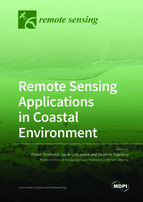Remote Sensing Applications in Coastal Environment
A special issue of Remote Sensing (ISSN 2072-4292). This special issue belongs to the section "Environmental Remote Sensing".
Deadline for manuscript submissions: closed (31 December 2020) | Viewed by 44946
Special Issue Editors
Interests: terrestrial laser scanner; remote sensing modeling of coastal environment; shoreline erosion; coastal geomorphology; coastal hazards; flood risk
Special Issues, Collections and Topics in MDPI journals
Interests: image processing; shoreline extraction; spatial analyses; digital terrain modeling; sea bottom modeling; big data set reduction; neural networks
Special Issues, Collections and Topics in MDPI journals
Special Issue Information
Dear Colleagues,
Coastal regions are susceptible to rapid changes as they constitute the boundary between the land and sea. The resilience of a particular segment of coast depends on many factors including climate change, sea-level changes, natural and technological hazards, extraction of natural resources, population growth, and tourism. Recent research highlights the strong capabilities for remote sensing applications to monitor, inventory, and analyze the coastal environment.
This Special Issue invites high-quality and innovative scientific papers that advance the science of remote sensing for coastal ecosystems through innovative approaches and novel applications. Articles that explore, evaluate, or implement the use of remote sensing sensors from UAVs through terrestrial scanners to spaceborne equipment within both natural or built coastal environments are welcome.
The following topics are particularly encouraged:
Applied topics
- Coastal storms and floods
- Sea-level rise
- Shoreline erosion
- Demographic and economic growth
- Land cover and use changes
- (Integrated) coastal zone management
Technical and algorithmic advances in
- coastal modeling
- RS/GIS applications
- airborne and terrestrial LiDAR
- detection of temporal changes
We are looking forward to your submissions.
Dr. Paweł Terefenko
Dr. Jacek Lubczonek
Dr. Dominik Paprotny
Guest Editors
Manuscript Submission Information
Manuscripts should be submitted online at www.mdpi.com by registering and logging in to this website. Once you are registered, click here to go to the submission form. Manuscripts can be submitted until the deadline. All submissions that pass pre-check are peer-reviewed. Accepted papers will be published continuously in the journal (as soon as accepted) and will be listed together on the special issue website. Research articles, review articles as well as short communications are invited. For planned papers, a title and short abstract (about 100 words) can be sent to the Editorial Office for announcement on this website.
Submitted manuscripts should not have been published previously, nor be under consideration for publication elsewhere (except conference proceedings papers). All manuscripts are thoroughly refereed through a single-blind peer-review process. A guide for authors and other relevant information for submission of manuscripts is available on the Instructions for Authors page. Remote Sensing is an international peer-reviewed open access semimonthly journal published by MDPI.
Please visit the Instructions for Authors page before submitting a manuscript. The Article Processing Charge (APC) for publication in this open access journal is 2700 CHF (Swiss Francs). Submitted papers should be well formatted and use good English. Authors may use MDPI's English editing service prior to publication or during author revisions.
Keywords
- Coastal process
- Terrestrial, airborne, and spaceborne remote sensing
- Sea-level rise
- Shoreline change
- Coastal geomorphology
- Coastal land use
- Risk and vulnerability assessment
- Climate change
- Coastal hazards
- ICZM







